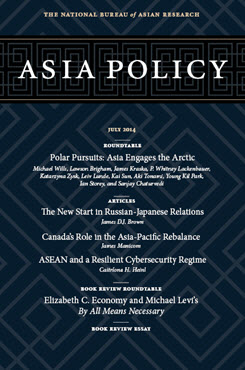The Changing Arctic
New Realities and Players at the Top of the World
This essay is part of the roundtable “Polar Pursuits: Asia Engages the Arctic.”
On December 6, 2012, the liquefied natural gas carrier Ob River arrived in the northern Japanese port of Tobata. Port arrivals by various types of cargo ships happen routinely every day around the world, but this voyage and arrival were special. The Ob River had departed November 7 from the northern Norwegian port of Hammerfest, sailed east across the Barents Sea, continued along Russia’s Northern Sea Route, and finally exited the Arctic Ocean through the Bering Strait on its way to Japan. Escorted in ice-covered waters by Russian nuclear icebreakers, this large, ice-capable ship had forged a late season, trans-Arctic maritime route from the Atlantic to the Pacific. [1] The voyage symbolized the ongoing globalization of the Arctic—the connection of Arctic natural resources to global markets—in an era when the region is also undergoing profound environmental changes as a result of anthropogenic warming at rates twice that of lower latitudes.
This essay argues that globalization, climate change, and regional geopolitics are intersecting and strongly influencing the future of the top of the world. No less important, the voice of the Arctic’s indigenous people, who have lived in the North for millennia, is being heard amid all the extraordinary change in the region. The eight states that have sovereign areas above the Arctic Circle—Canada, Denmark (Greenland), Finland, Iceland, Norway, Russia, Sweden, and the United States—are challenged to protect their Arctic peoples and the environment while also developing their northern lands and seas in sustainable ways. The Arctic states have created and nurtured the Arctic Council and have in May 2013 admitted five Asian observers. The roles these Asian observers can play in Arctic affairs within the council and at large in the world are a key focus of this essay.
A Melting Arctic and Growing Globalization
Extraordinary changes in the Arctic’s physical environment have been observed. Arctic sea ice is undergoing a historic transformation of thinning and reduction in area that has implications for potentially longer seasons of navigation and access to once remote coastal seas. [2] The changes in the sea ice area and observed reduction in snow-cover duration in Eurasia and North America mean that smaller Arctic areas are less reflective of incoming sunlight, causing the exposed land and sea to absorb more heat. Permafrost is melting and releasing methane (a greenhouse gas), which could result in additional warming of the atmosphere. Of importance for the rise of global sea levels, the Greenland ice sheet (as well as Canadian and Alaskan glaciers) has been losing mass because of the melting of the surface ice sheet and iceberg calving. The Arctic’s ecosystems have been observed to be highly sensitive to such temperature increases, which have caused the loss of sea ice habitat for marine mammals, changes to the marine food chain, and increases in tundra greenness and biomass. The marine and terrestrial ecosystem changes, increasing coastal erosion, and overall warming present serious challenges to all Arctic indigenous peoples. [3]
While these physical changes have been occurring, the globalization of the Arctic has begun as a result of new economic pressures to link Arctic natural resources to global markets. Higher global commodities prices and improving Arctic access have been drivers of increased attention to what is viewed by many as a global storehouse of desirable natural resources, including hydrocarbons; fisheries; hard minerals such as nickel, palladium, zinc, platinum, diamonds, and coal; rare earths; and freshwater. These strong climatic and economic forces present an array of unique challenges to the existing legal and regulatory structures, which cannot meet today’s needs for protecting Arctic peoples and the environment.
The Changing Role of the Arctic Council
The Arctic Council is an intergovernmental forum, established by the Arctic states in the 1996 Ottawa Declaration, that plays a central role today in managing and shaping international relations in the Arctic. As a consensus body, the council’s focus by charter is on environmental…
Endnotes
[1] “Gazprom Successfully Completes World’s First LNG Supply Northern Sea Route,” Gazprom, Press Release, December 5, 2012.
[2]Arctic Council, “Arctic Marine Shipping Assessment 2009 Report,” April 29, 2009.
[3]For an analysis of the full range of Arctic climate changes and impacts, see the Arctic Council, “Arctic Climate Impact Assessment,” November 24, 2004, http://www.acia.uaf.edu/PDFs/ACIA_Policy_Document.pdf.
About Asia Policy
Asia Policy is a peer-reviewed scholarly journal presenting policy-relevant academic research on the Asia-Pacific that draws clear and concise conclusions useful to today’s policymakers. Asia Policy is published quarterly in January, April, July, and October and accepts submissions on a rolling basis. Learn more


